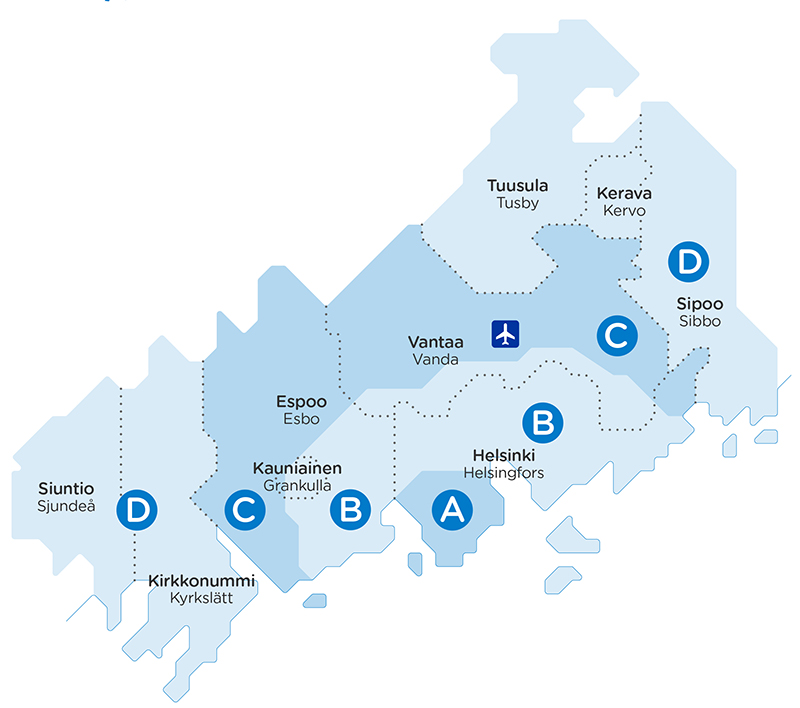According to the proposal, the new 30-day AB ticket would cost five euros more than the current city internal season ticket. However, the new ticket will allow passengers to travel in a much larger area than the current internal tickets. Consequently, for many season ticket users, the total cost of travel will actually decrease as they no longer need to buy single tickets for journeys outside the validity zone of their current season ticket. Those season ticket users, who will only need an AB or BC ticket, will in the future pay 44 percent or almost 47 euros less for their season ticket than at present. In addition, HSL will introduce an annual ticket that is payable monthly, providing the most ecomical way to use public transport.
“The new fare zones will meet the needs of the expanding Helsinki region with its increasingly compact urban form and growing population. The Helsinki region constitutes an integrated commuting area, where residents travel across municipal boundaries. In many places, the closest shopping center, library or swimming hall may be in the neighboring municipality. In additin, the region’s municipalities are increasingly developing their services so that it is easy to use them across municipal boundaries. The new zone model will, in many cases, make travel across municipal boundaries much cheaper than at present,” says Suvi Rihtniemi, the Executive Director of HSL.
The current ticket zones follow municipal boundaries and short journeys across municipal boundaries are expensive relative to the distance travelled. Another problem is that the journeys made with the same ticket can vary a lot in length: in the east, you can travel all the way to the border of Sipoo, while in the west, the regional ticket zone begins already in Hanasaari.
In addition, the new model will simplify the ticketing system. The current tickets and their validity zones are difficult to understand: what do region, extended region 2 and extended region 3 mean? Zones radiating from the center of Helsinki, indicated by letters ABCD are easier to understand.
According to forecast models, the new zones will increase the use of public transport across the region by one percent in the long-term. The figure may sound small but it is a significant shift as the total number of public transport journeys in the region is over 370 million a year. Public transport passenger kilometers will increase even more, by about five per cent, as the distances travelled increase. The use of public transport is expected to increase the most in the large B zone, where public transport supply is good. About half of the HSL area population, over 600,000 people, live in Zone B.
What will the tickets cost?
The Executive Board of HSL will decide the ticket prices for 2019 in autumn 2018. On 12 June, the Board will circulate the Operational and Financial Plan 2019-2021 to municipalities for comments. The prices are proposals used to calculate the budget. The Executive Board of HSL will decide the prices on the basis of the municipalities’ statements on the Operational and Financial Plan in autumn 2018. The ticket revenue goal set out in the plan is 371.3 million euros.
The following ticket prices were used when drawing up the Operational and Financial Plan 2019–2021:
| AB | BC | ABC | CD | BCD | D | ABCD | |
| Single ticket | 2.80 | 2.80 | 4.60 | 4.60 | 5.40 | 2.80 | 6.50 |
| Season ticket 30 days | 59.70 | 59.70 | 107.50 | 107.50 | 115.80 | 59.70 | 157.60 |
| Annual ticket | 53.00 | 53.00 | 96.00 | 96.00 | 104.00 | 53.00 | 141.00 |
“We have made various calculations of prices during the course of developing the plan. The prices now proposed are based on a growing population and increasing public transport ridership, as well as on keeping the share of municipal funding at 50 percent,” says Suvi Rihtniemi.
According to the proposal, AB and BC tickets would be slightly more expensive that the current one-zone tickets. In case of 30-day tickets, the price difference would be five euros. However, the area covered by the new ticket will be so much larger that even one journey a month outside the validity zone of the current internal tickets will make the new tickets cheaper compared to the current ones. For example, a resident of Helsinki, who has a Helsinki internal season ticket, currently pays over 5 euros for a return journey to e.g. Tapiola, Leppävaara or Myyrmäki, as the cheapest single ticket from Helsinki to Espoo now costs 4.20 euros.
The calculations also include a new annual ticket, payable montly, that is valid for at least 12 months. The new AB or BC annual ticket would cost about 10 per cent less tan thhe current internal 30-day ticket.
